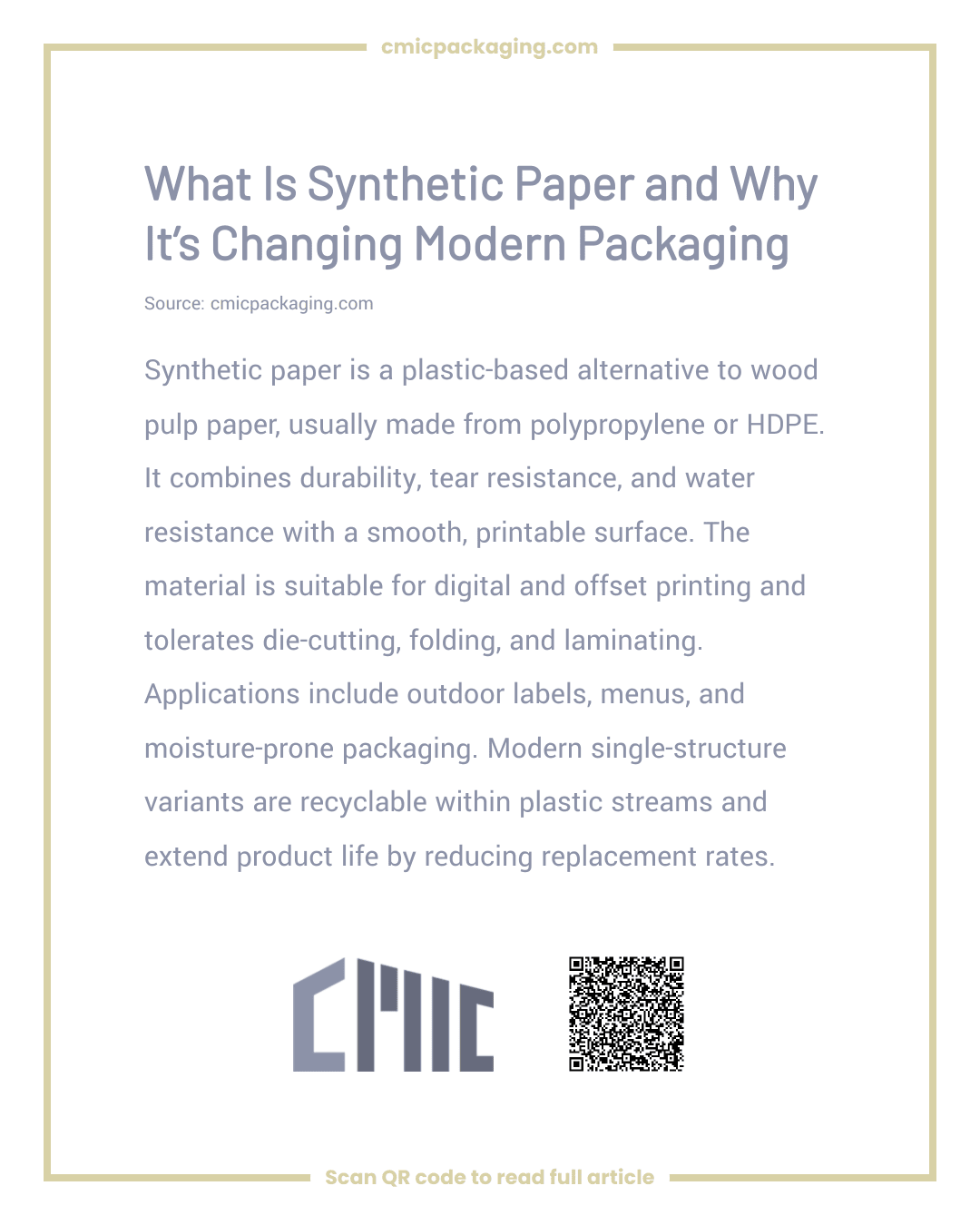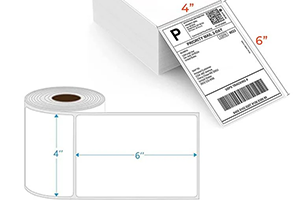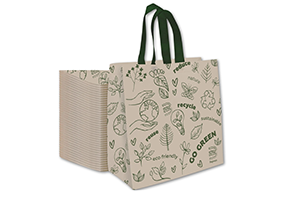Ever pulled a crumpled map out of your backpack after it’s been squished in there for weeks, and it still looks as fresh as the day you bought it? Or wiped a splash of sauce off a restaurant menu without it turning into a soggy mess? That’s the kind of wizardry synthetic paper brings to the table – a tough, printable wonder that’s built to handle life’s messiest moments.
Forget the brittle wood-pulp paper we’ve all scribbled on since school days. Synthetic paper is basically plastic’s clever disguise as paper, made from stuff like polypropylene or high-density polyethylene (HDPE). It feels just like the real deal but cranks the durability up to eleven. Imagine paper’s tough-as-nails cousin who shrugs off rain, rips, and the ravages of time – bendy, but unbreakable.
Over the years, I’ve seen companies in everything from outdoor labeling to sturdy packaging and even timeless archives jumping on this bandwagon. As someone who’s been knee-deep in packaging trends for ages, I can tell you: with everyone chasing sustainability and stuff that lasts, understanding synthetic paper isn’t just a nice-to-have. It’s a must if you’re a packaging pro or brand owner aiming to keep things fresh and ahead of the curve.
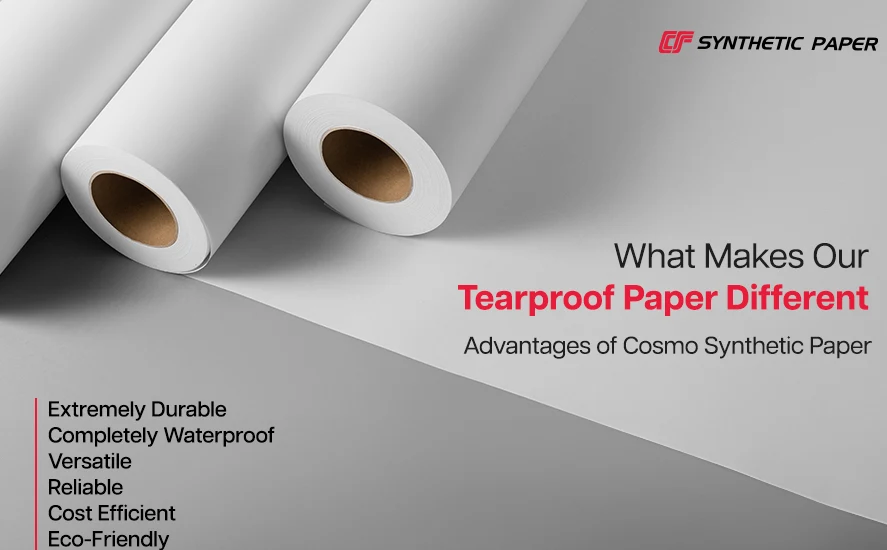
The Story Behind Synthetic Paper’s Rise
We’ve relied on traditional paper for printing and packaging forever, but come on, it’s got some real weaknesses. It tears if you look at it funny, drinks up water like it’s parched, and fades quicker than your holiday glow under the sun. Not ideal for things like food delivery boxes that get battered, outdoor tags in the rain, or industrial labels facing daily grind.
So, clever folks started experimenting with synthetics that mimic paper’s texture and printability while standing up to whatever Mother Nature throws. Cue synthetic paper: a smart blend of plastic films and special coatings. It wasn’t all about brute strength, though – it sneaks in efficiency and a nod to the environment too. While old-school paper chugs through tons of water in pulping and bleaching, synthetic options are lighter on resources and often fully recyclable. I’ve come across some nifty eco versions that recycle easily or even turn into energy without a fuss – worlds away from the wasteful ways of the past.
Standout Features That Make Synthetic Paper a Winner
What hooks me every time about synthetic paper is how it nails the best of both worlds – paper’s charm with plastic’s grit. Let me spill on why it’s such a standout.
For starters, it’s ridiculously waterproof and weatherproof. Rain, chemicals, humidity? It just chuckles and carries on, making it a dream for outdoor signs, labels, or packaging that faces downpours or wild temperature flips.
Tear-resistance? A game-changer. Regular paper falls apart like wet tissue, but this one’s got a plastic core that takes a beating. I’ve got maps and manuals from my own travels that emerged from backpack chaos without a nick.
And the printing? Spot-on. That special coating grabs ink like a pro, spitting out crisp text and popping colors, whether you’re digital or old-school offset. The results? Always sharp and sleek.
It’s super versatile – comes in various thicknesses, folds and cuts like a champ, no need to revamp your whole operation. Oh, and UV resistance means colors stay vivid even after sunbathing, perfect for garden gear labels or travel docs that get knocked around.
Where Synthetic Paper is Making Waves in Packaging and More
This sneaky material has wormed its way into loads of industries, and honestly, it’s no surprise – it’s a silent superstar. Here’s where it’s really stealing the show, from what I’ve witnessed.
Product labels and tags? From fizzy drink bottles to chemical drums, it keeps everything crisp and stuck, no matter the splashes. No wrinkles, no peels – just solid performance.
In food and bev packaging, picture grease-proof menus, wraps, and inserts that survive steamy kitchens or bumpy deliveries. Cafes and brands rave about how it keeps that fancy feel without crumbling.
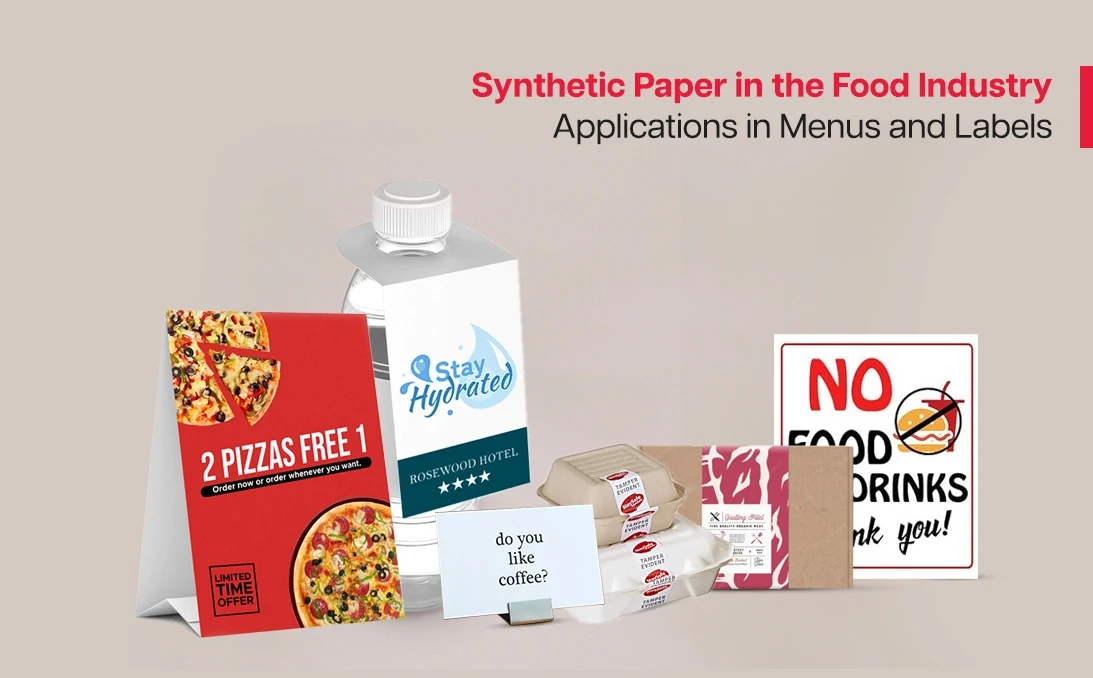
Outdoors or in tough industrial spots, it’s the go-to for safety signs, warehouse labels, and displays that laugh off UV rays, chemicals, and scrapes. Lasts longer, saves money on swaps, and hey, it’s kinder to the earth.
For brochures, maps, and guides in commercial printing? It adds that premium edge with durability you can actually use. In niche areas like medical packs or logistics, its smooth surface is a barcode’s best friend – no pesky fibers gumming up scans.
I remember consulting for a logistics outfit drowning in smudged tags from humid warehouses. They switched to synthetic paper, fixed the mess, cut rework by 40%, and stayed fully recyclable. Talk about a win-win.
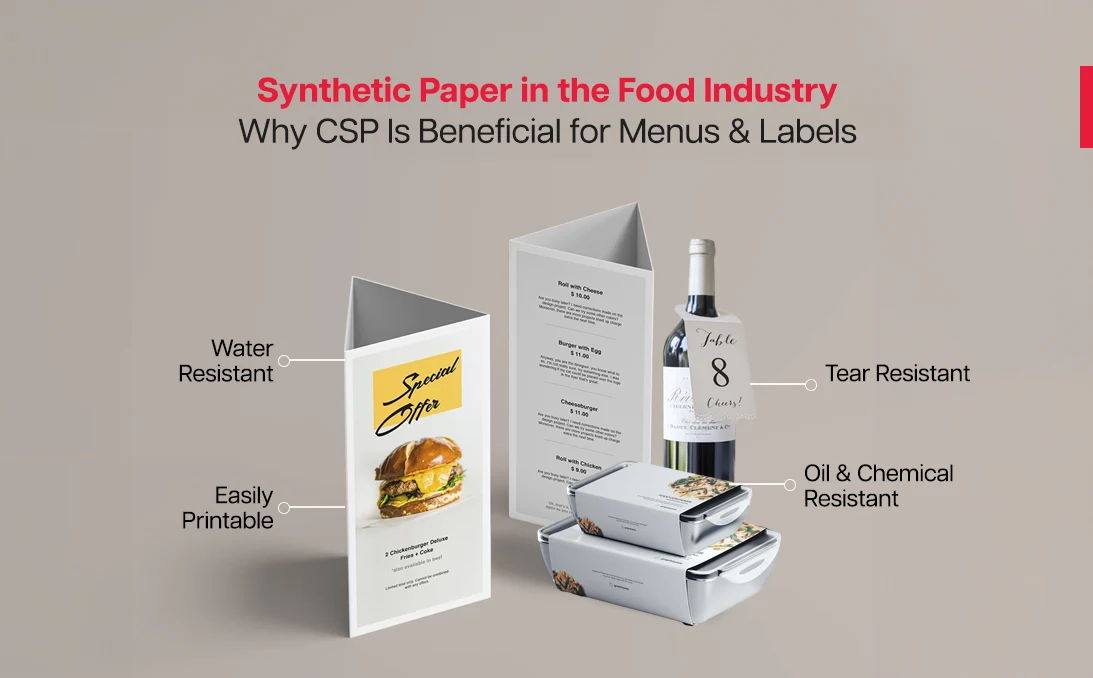
Digging Into Synthetic Paper’s Eco Credentials
Now, the elephant in the room: Is synthetic paper really green, or just greenwashing? The plastic tag might make you skeptical, but today’s versions are smarter than you think.
Plenty are 100% recyclable through regular plastic channels – not the fiddly mixed stuff, but simple films that remake easily. Their long life means less waste from endless reprints; it’s all about that “use it longer, toss it less” vibe.
At spots like C MIC Packaging, they pull from certified suppliers who nail recyclability and safe end-of-life options. In my book, when it stops needless resource drain in lasting applications, it’s a quiet eco champion.
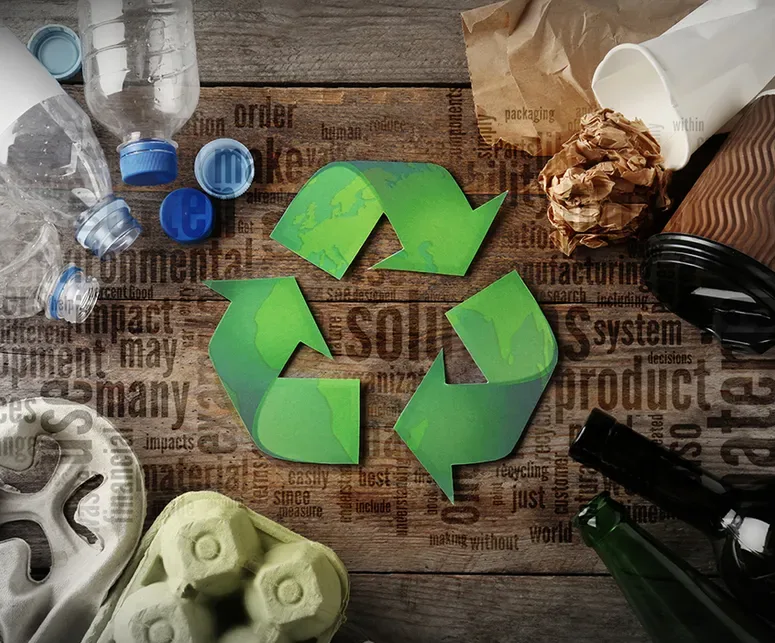
How Synthetic Paper Stacks Up Against the Classics
To paint the picture, here’s a no-frills comparison of the key bits:
| Feature |
Traditional Paper |
Synthetic Paper |
| Base Material |
Wood pulp |
Polypropylene or HDPE |
| Water Resistance |
Poor |
Excellent |
| Tear Resistance |
Weak |
Very strong |
| Printability |
Excellent |
Excellent |
| Outdoor Durability |
Low |
High |
| Sustainability |
Recyclable, biodegradable |
Recyclable, long-life |
| Ideal Use |
Everyday print, indoor packs |
Outdoor use, long-life packaging |
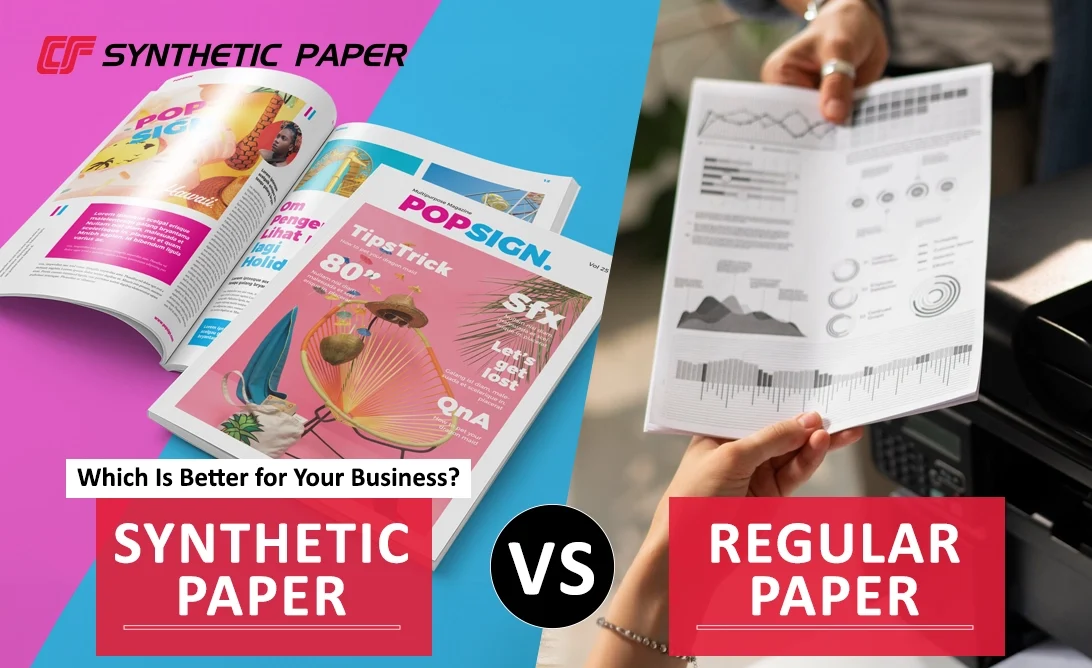
Picking Synthetic Paper for Your Packaging Game
A question that pops up all the time: Will it mesh with my existing printers or cutters? Spoiler: Usually, yeah, it slides right in.
It runs smoothly on digital and offset setups, folds and glues like coated paperboard. The perk? Its toughness cuts down on waste and do-overs, ramping up your efficiency.
At C MIC Packaging, we’ve guided heaps of brands through the switch for rigid boxes, smart labels, and shipping tags. Clients keep saying how these weather-beating sheets slash gripes about moisture-ruined shipments, especially on those humid Asia-to-global runs.
When to Go All-In on Synthetic Paper
Quick vibe check: If you’re after waterproof magic for outdoor or chilled packs, tear-proof labels or guides, primo print surfaces for intricate designs, toughness against handling or chemicals, or a recyclable option that endures – grab it.
Ticking a few boxes? Time to level up your brand’s staying power.
A Real-Life Win I Can’t Forget
Get this: A big skincare brand was battling labels that peeled off during sweaty export trips. They swapped to synthetic paper, and bam – problems vanished. Boxes showed up spotless after ocean voyages, and they halved replacement costs without touching their gear.
C MIC Packaging steered them through, tweaking thicknesses and glues for flawless digital prints. The result? Slicker visuals, tougher performance, and a boost in eco cred with picky customers. Another gem: A drink company I know ditched fading tags on outdoor coolers for synthetic ones – now their branding stays bold through storms and sun.
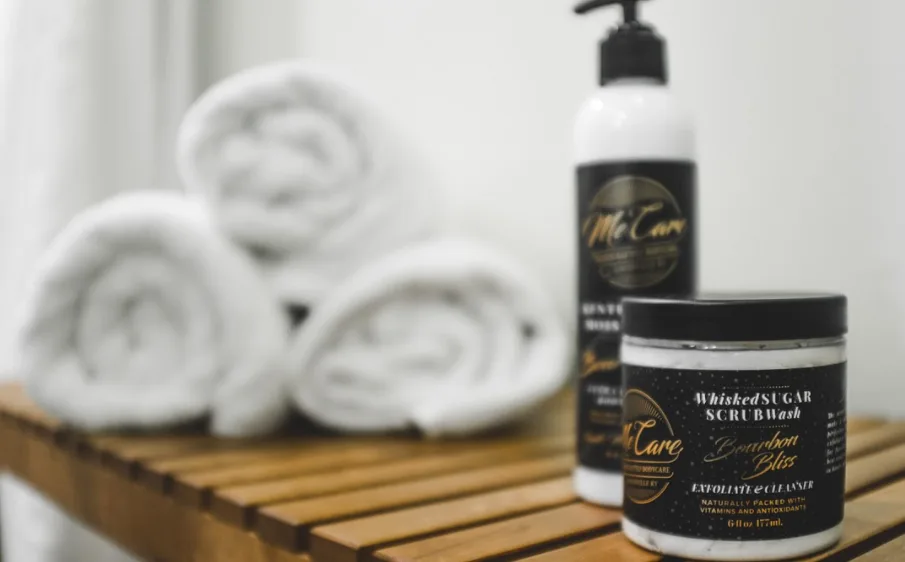
Wrapping It Up
Synthetic paper hits that perfect blend of plastic smarts and paper charm – durable, waterproof, recyclable, and geared for today’s packaging headaches. It takes a licking from rough handling and weather but still delivers prints that make unboxings memorable.
If you’re in packaging or running a brand, it’s your secret weapon for looks that endure. Need a durability upgrade against the elements? This might just be the call you’ve been waiting for.
Wondering how it fits into your rigid boxes, flexible labels, or export cartons? Swing by C MIC Packaging for tailored advice and samples that match your tough needs and green dreams. I’ve seen it flip brands around – trust me, it’s a game worth playing.
